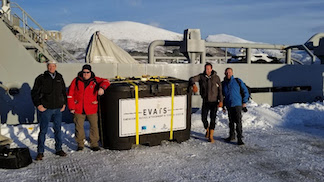(FERNDALE, Wash.) — Samson, a leading developer of high-performance synthetic rope solutions and a global market leader in commercial marine applications, has announced the completion of a sea exercise to further validate performance of the recently developed EVATS (emergency vessel attachment and towing) system. This emergency towing exercise was led by the Norwegian Coastal Administration in a fjord southwest of Sortland, Norway, during scheduled training exercises.
Samson, the Alaska Maritime Prevention & Response Network (Alaska Network) and Kystvakte (Norwegian coast guard) crewmembers participated in a system briefing and orientation on March 7, and then commenced the sea trial on the March 8. Two Kystvakte vessels, KV Barentshav and KV Sortland, were used in the exercise to test the EVATS system in an on-water towing configuration for the first time. The purpose of the exercise was to demonstrate the enhanced capabilities of the system.
EVATS is designed to make the towing connection to a disabled vessel at sea safer and significantly more efficient than current practices, reducing risk and increasing the probability of a favorable outcome. Since most vessels are not outfitted with dedicated strongpoints and emergency towing arrangements, the EVATS system is designed to have near-universal compatibility, accounting for known differences in vessels. The primary strength members, high-performance synthetic rope designed by Samson, allow for easy handling, quick deployment, and low system weight.
During the test, the team was able to successfully deploy, test and recover the EVATS. Tension gauges on the tow winch indicated 25 MT-plus on the tension mode and 50 MT-plus on the brake mode. The hawser bushing, a unique and critical component of the patented EVATS system, slid well, with the load-sharing features’ effectiveness clearly demonstrated. Recovery and inspection of the system showed no abrading or damage that would undermine immediate reuse of the system. Upon completion of the exercise and detailed debrief, the full test team concluded that the exercise was a success. The EVATS system demonstrated itself as effective and practical, far exceeding expectations of the Samson and Alaska Network test team.
“Congratulations to the entire team in successfully field testing the EVATS. This is a significant milestone in demonstrating to the maritime community how this system, using cutting-edge rope technology, enhances emergency towing safety and effectiveness under the very unpredictable and hazardous nature during an emergency tow of a distressed oceangoing vessel,” said Buddy Custard, president and chief executive officer for the Alaska Maritime Prevention & Response Network. “On behalf of the 465 member shipping companies the Alaska Network supports, I sincerely appreciate the interest and professionalism of the Norwegian coast guard who made this exercise a safe and successful undertaking.”
“Working with experts in exercises such as these allows us to optimize design and develop solutions that work,” said Heather Newland, director of commercial marine for Samson. “Much appreciation to the Norwegian Coastal Administration for taking part in this trial and for their interest and dedication to continued safety improvements in emergency towing.”
The EVATS system development team included Glosten, a Seattle, Wash.-based marine engineering firm, with technical support from Samson, input from salvage engineers and the Alaska Network who provided funding and overall guidance on the project. EVATS is devised for easy deployment in emergency towing and near-shore salvage operations, and it can be delivered either from the towing vessel or via rescue helicopter.
Click here to watch a video of the test. For more information about Samson, visit www.samsonrope.com.

